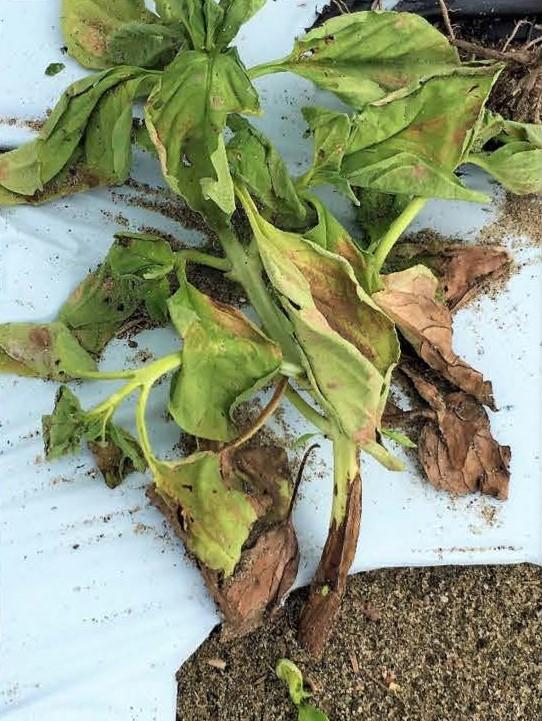Fusarium Wilt in Basil

Usually when anyone talks about basil problems they talk about basil downy mildew, but there are unfortunately other disease problems with basil that are important and need to be managed. One basil disease that has been found in the field this season is Fusarium wilt, caused by the fungus Fusarium oxysporum f. sp. basilicum. It was first found in the U.S. in North Carolina thirty years ago and has now spread throughout North America. Basil plants (sweet basil only) infected with Fusarium wilt usually grow without any symptoms until they are about 8- 12 inches tall, at which point they become stunted and begin to wilt. Initial symptoms usually include brown streaks starting on the lower areas of stems and discoloration of the internal stem tissue (Fig. 1). Leaves become yellow and malformed and may curl. Wilted plants can develop a shepherd’s crook and plants can suddenly lose their leaves. A pink-orange layer of mold may cover stems when it is very moist. The disease is spread by air or soil and can be seedborne. Once a field has become infested with the fusarium wilt pathogen, infective propagules may persist in the soil for 8-12 years. The best management practices include planting disease free basil seed. If you can’t get tested seed, soak your seed in cold water for 4-hours and then transfer the seed to a heat treatment of 20 minutes in 133-136° F water. The hot water treatment causes a sticky layer to develop on the outer surface of the seed making it very slippery and this treatment will reduce germination. There are now Fusarium resistant sweet basil cultivars available such as Aroma-2, Prospera and Obsession as well as others. If Fusarium wilt is introduced into the field growers should not grow any sweet basil or members of the mint family in that field for at least 2-3 years. Mint plants will not show any symptoms of fusarium wilt but they will act as hosts for the disease. Some of the specialty basils, such as lemon or purple basil, show resistance to the disease. A few biologicals that have demonstrated some reduction in disease incidence are Actinovate as a soil drench at planting and Rootshield as an in-furrow spray.
Return to Horticulture and Disease Topics
This article appears on September 9, 2021, Volume 12, Issue 6 of the Vegetable and Fruit News